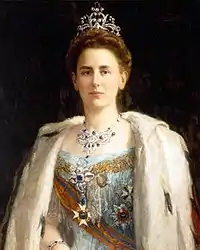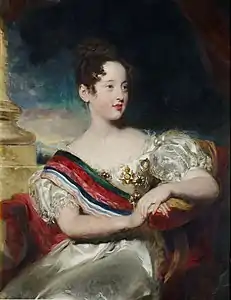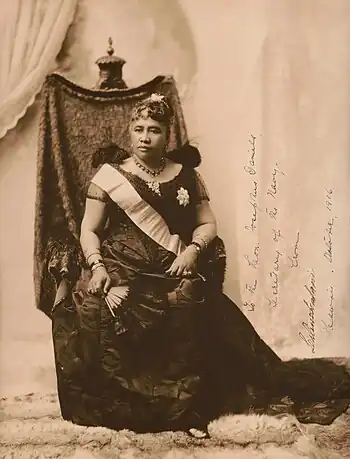List of women monarchs
This is a list of current and former female monarchs regardless of title, including queens regnant, empresses regnant, pharaohs and monarchs by other titles (grand duchess, princess etc.). Queens consort (i.e. wives to male monarchs) are not included, see List of current consorts of sovereigns. Queens regent or female regents are not included, see List of regents.

_(cropped)_(3-to-4_aspect_ratio).jpg.webp)
The following is an incomplete list of women monarchs who are well known from popular writings, although many ancient and poorly documented ruling monarchs (such as those from Africa and Oceania) are omitted. Section 1 lists Queens regnant: monarchs who ruled in their own right. Section 2 lists Legendary queens. Section 3 lists Constituent queens: Queens who ruled in their own right, but had no constitutional standing or regal powers while in power. Section 4 lists various female leaders who were referred to as "Chieftainess." Queens regent are not monarchs and are not included in this page. Pretenders to thrones are also not included in this page.
Monarchs
Algeria
- Tin Hinan, queen of Hoggar Mountains (ruled c. 4th-century)
- Kahina, queen of Kingdom of the Aurès (ruled c. 690–703)
Egypt
- Sobekneferu (r. 1806–1802 BC) of the Twelfth Dynasty – Sobekneferu was the first confirmed female ruler of Egypt, although Nitocris may have ruled in the Sixth Dynasty, and queens such as Neithhotep, Merneith and Khentkaus I may have reigned in their own right, though archaeological evidence is lacking. Sobekneferu was a daughter of Amenemhat III and ascended the throne after the death of Amenemhat IV, who may have been her brother.
- Hatshepsut (c. 1479–1458 BC) of the Eighteenth Dynasty – Daughter of Thutmose I and sister-wife of Thutmose II. She initially ruled as regent for her nephew Thutmose III before claiming pharaonic titles as his co-ruler.
- Neferneferuaten (c. 1334–1332 BC) of the Eighteenth Dynasty – The identity of this queen is debated. She is often considered to be Nefertiti, wife of Akhenaten, but may have instead been Meritaten, Akhenaten's daughter.
- Twosret (c. 1191–1189 BC) of the Nineteenth Dynasty – Wife of Seti II. She ruled as regent for Siptah before ascending the throne after his death.

Ptolemy II instituted a new practice of brother-sister marriage when he married his full sister, Arsinoe II. They became, in effect, co-rulers, and both took the epithet Philadelphus ("Brother-Loving" and "Sister-Loving"). Because of this custom many of the kings ruled jointly with their spouses, who were also of the royal house. The only Ptolemaic Queens who ruled alone were Cleopatra II, Berenice III and Berenice IV. Cleopatra VI did co-rule, but it was with another female, Berenice IV. Cleopatra VII officially co-ruled with Ptolemy XIII Theos Philopator, Ptolemy XIV, and Ptolemy XV, but effectively, she ruled Egypt alone.
- Arsinoe II (277–270 BC) – Daughter of Ptolemy I Soter and sister-wife of Ptolemy II Philadelphus.
- Berenice II (246–222 BC) – Wife of Ptolemy III Euergetes.
- Arsinoe III (220–204 BC) – Daughter of Ptolemy III Euergetes and Berenice II, and sister-wife of Ptolemy IV Philopator.
- Cleopatra I (193–176 BC) – Wife of Ptolemy V Epiphanes and mother of Ptolemy VI Philometor.
- Cleopatra II (175–164, 163–127, 124–116 BC) – Daughter of Ptolemy V Epiphanes and Cleopatra I Syra, sister-wife to both Ptolemy VI Philometor and Ptolemy VIII Physcon, and mother of Ptolemy VII Neos Philopator.
- Cleopatra III (142–131, 127–101 BC) – Daughter of Ptolemy VI Philometor and Cleopatra II, and mother of Ptolemy IX Soter, Ptolemy X Alexander I and Cleopatra IV.
- Cleopatra IV (116–115 BC) – Daughter of Ptolemy VIII Physcon and Cleopatra III, and sister-wife of Ptolemy IX Soter.
- Berenice III (101–88, 81–80 BC) – Daughter of Ptolemy IX Soter and sister-wife to both Ptolemy X Alexander I and Ptolemy XI Alexander II.
- Cleopatra V (79–69 BC) – Wife of Ptolemy XII Auletes.
- Cleopatra VI (58–57 BC) – Either wife or daughter of Ptolemy XII Auletes. She may be the same person as Cleopatra V.
- Berenice IV (58–55 BC) – Daughter of Ptolemy XII Auletes and Cleopatra V.
- Cleopatra VII (51–30 BC) – Daughter of Ptolemy XII Auletes and mother of Caesarion.
- Arsinoe IV (48–47 BC) – Daughter of Ptolemy XII Auletes who ruled in opposition to her sister Cleopatra VII.
- Zenobia (270–272) – She took Roman Egypt by Palmyrene invasion and was declared Queen of Egypt.
- Shajar al-Durr (1250) – Wife of sultans As-Salih Ayyub and Aybak.
Libya
- Berenice II - Berenice, queen of Cyrene, married Ptolemy III, pharaoh of the Ptolemaic dynasty. This brought Cyrene back into the Ptolemaic realm and she became co-regent queen of the Ptolemaic Dynasty.
- Cleopatra Selene II (ruled 34–30 BC) – also known as Cleopatra VIII. In 75 BC, Cyrene became part of a Roman province, but it was restored to the Ptolemies by Mark Antony in 37 BC. In 34 BC Cleopatra VII and Antony's daughter, Cleopatra Selene II, was made Queen of Cyrene, but the city returned to Rome following Augustus' conquest of Egypt in 30 BC
Sudan
Egyptian Empire (c. 1500–1070 BCE)
- Hatshepsut (r. 1479–1458 BCE)
- Neferneferuaten (r. 1334–1332 BCE)
- Twosret (r. 1191–1189 BCE)
Kingdom of Kush (c. 1070 BCE–350 CE)
Kandake was a title for queens, queen mothers, and queens consort in Nubia, but ruling Kandakes included:
- Nahirqo
- Ruling Queen, name unknown, buried in Bar. 8[1]
- Amanirenas (ruled 40–10 BCE)
- Amanishakheto (ruled c. 10 BCE–1 CE)
- Shanakdakhete
- Nawidemak (ruled c. 1st century CE)
- Amanitore (ruled 1–20 CE) – she ruled with her husband or son Natakamani
- Amanikhatashan (ruled 62–85 CE)
- Amanikhalika
- Patrapeamani (de:Patrapeamani) (ruled early 4th century CE)
- Amanipilade (ruled 308–325 CE)
Dotawo (Lower Nubia)
Gambia
- Elizabeth II (reigned 1965–1970)
Ghana
- Elizabeth II (reigned 1957–1960)
- Amoako Atta Yiadom (ruled 1770–1793), Denkyirahene
- Ama Serwah (ruled 1838–1846), Dwabenhene
- Unknown Dwabenhene (ruled 1846-18??)
- Nana Juaben Serwah II (ruled 1959–19??), Dwabenhene
Guinea-Bissau
- Okinka Aurelia Correia (ruled r. 1830–1874/1879)[3]
- Okinka Pampa Kanyimpa (ruled c. 1910–1930) – Succeeded her father Bankajapa.
Côte d'Ivoire
Nigeria
- Elizabeth II (1960–1963)
The title "Kabara" was used by female monarchs who ruled over the Hausa people in medieval times. A line of matriarchal monarchs is recorded in the Kano Chronicle that ends with the reign of Daurama in the 9th century.[5] These queens reigned from c. 700 to c. 1000.[6]
- Kufuru
- Ginu
- Yakumo
- Yakunya
- Wanzamu
- Yanbamu
- Gizir-gizir
- Inna-Gari
- Daurama
- Ga-Wata
- Shata
- Fatatuma
- Sai-Da-Mata
- Ja-Mata
- Ha-Mata
- Zama
- Sha-Wata
- Daurama II
- Emose (584–600)
- Orrorro (600–618)
- Pupupu, founder and ruler of the Ondo Kingdom c. 1510.
- Amina – There is controversy among scholars as to the date of her reign, one school placing her in the mid-15th century, and a second placing her reign in the mid to late 16th century.
- Ooni Luwoo (10th century)
Senegal
Lingeer's leadership activities were carried out at the highest tier, as a co-monarch.
- Lingeer Fatim Beye (ruled c. 1335)
- Lingeer Ndoye Demba (ruled c. 1367) – she was the founder of the Serer Joos Maternal Dynasty
- Lingeer Ngoné Dièye
- Njembot Mbodj
- Ndaté Yalla Mbodj
- Lingeer Selbeh Ndoffene Joof
Sierra Leone
- Elizabeth II (1961–1971)
- Fatima Brima Kama, Alikali (ruled 1826–1840), Bai
Angola
- Mussasa (17th century)
- Tembandumba

- Mwongo Matamba (ruled ?–1631) – she was captured and deposed by Ana Nzinga in 1631
- Ana I de Sousa Nzinga Mbande (ruled 1631–1663)
- Barbara (ruled 1663–1666)
- Verónica I Guterres Kandala Kingwanga (ruled 1681–1721)
- Ana II (ruled 1742–1756)
- Verónica II (ruled 1756–1758)
- Ana III (ruled 1758–1767)
- Vamwene Naama
- Vamwene Yamvu
- Vamwene Mbaao ya Chinguli (ruled 1500s–early 1600s)
- Vamwene Kaamba ka Mbaao
- Vamwene Mukenge wa Lweembe, Livindamo
- Ana de Sousa Nzinga Mbande (ruled 1624–1626 and 1657–1663)
- Mukambu Mbandi (ruled 1663–1671)
Kingdom of Jinga
There were two female monarchs during Kongo Civil War.
- Ana Afonso de Leão, queen of Kinlaza
- Suzana de Nóbrega (pt:Suzana de Nóbrega), queen of Kimpanzu
Cameroon
- Soukda, founder of Mandara Kingdom (ruled c. 1500)
- Ngoungoure, queen of Bamum (ruled 1865) – her rule lasted 30 minutes
Comoros
Ndzuwani (Anjouan)
- Alimah I (ruled during the 16th century – unknown start date, reigned ended in c. 1590)
- Alimah II (ruled c. 1632–c. 1676)
- Alimah III (ruled c. 1676–c. 1711)
- Alimah IV (ruled 1788–1792) – she was the de facto ruler of Anjouan with sultan Abdallah I during his reigns in 1782–1788 and 1792–1796.
Bamboa
- Nyau wa Faume
- Fey Beja waWabeja, Mfalme
- Ja Mhaba, Mfalme
- Hadija bint Ahmed, Mfalme
- Raketaka Jombe Sudy (ruled 1842–1865 and 1874–1878) – she also ruled as regent twice, 1865–1868 and 1871–1874. After 1851 she took the name of Jumbe Fatima bint Abderremane
- Salima Machamba bint Saidi Hamadi Makadara (ruled 1888–1909)
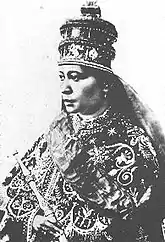
Ethiopia
- Zewditu (ruled 1916–1930) – Daughter of Menelik II. She ascended to the throne after her nephew Iyasu V was deposed.
Kenya
- Elizabeth II (1963–1964)
Names taken from Female Rule in the Indian Ocean World (1300–1900).[7]
- Mwana Masuru
- Maryamu
- Mwana Mkisi
- Mwana Inali
- Mwana Darini binti Bwana Mkuu bin Abubakar
- Asha binti Muhammad
- Mwanai Mimi
- Mwana Khadija binti Omari
Madagascar
- Rangita (ruled 1520–1530) – Daughter of king Rafandramanenitra.
- Rafohy (ruled 1530–1540) – Daughter of queen Rangita.
- Ranavalona I (ruled 1828–1861) – Wife of Radama I.
- Rasoherina (ruled 1863–1868) – Wife of Radama II.
- Ranavalona II (ruled 1868–1883) – Wife of Radama II and cousin of Rasoherina.
- Ranavalona III (ruled 1883–1897) – Niece of Ranavalona II.
The female monarchs of Madagascar traditional states were:[8]
- Ramananandrianjaka Rambolamasoandro
- Rabehety
- Andrianaginarivo (ruled 1777–1778)
- Tombola (ruled 1778)
- Ravahiny (ruled 1778–1808)
- Oantitsy (ruled 1832–1836)
- Tsiomeko (ruled 1836–1840)
- Bibiasa
Bemihisatra
Bemazava
- Irana Andriamamelonarivo
- Tsiresy I Andriamanomponarivo
- Tsiresy II Nenimoana
- Ambary of Antankarana
- Soanaomby
Imarovatana
- Ramanandrianjaka II Ravorombato
Mauritius
- Elizabeth II (1968–1992)
South Sudan
Tanzania
- Elizabeth II (1961–1962)
- Therese Ntare VI of Heru[10]
Names taken from Female Rule in the Indian Ocean World (1300–1900).[7]
- Mwana Aziz
- Mwana Miveni
- Mwana Aisha
- Mwana Fatuma binti Darhash
- Mwana Hadiya
- Mwana Mize binti Muaba
- Mwana Mwema, queen of Unguja[11] (ruled ?–1653)[12]
- Fatuma binti Yussuf, queen of Unguja (ruled ?–1698 and 1709–1715)
- Mwana wa Mwana
- Mwanzuani
- Mwana Khazija binti Ngwali
- Fatuma binti Ali
- Sabini binti Ngumi
Uganda
- Elizabeth II (1962–1963)
- Masamba of Bunyoro (early 17th century; 5 Years)
- Akech (queen) (1760–1787)
Malawi
- Elizabeth II (1964–1966)
Namibia
- Nandundu (ruled 1830–1832)
Oukwanyama kingdom
- Martha Mwadinomho Nelumbu
South Africa
- Elizabeth II (1952–1961)
The Modjadji or Rain Queen is the hereditary queen of Lobedu, the people of the Limpopo Province of South Africa. The succession to the position of Rain Queen is matrilineal, meaning that the Queen's eldest daughter is the heir, and that males are not entitled to inherit the throne at all. The Rain Queen is believed to have special powers, including the ability to control the clouds and rainfall.
- Maselekwane Modjadji (1800–1854)
- Masalanabo I Modjadji (1854–1894)
- Khetoane Modjadji (1895–1959)
- Makoma Modjadji (1959–1980)
- Mokope Modjadji (1981–2001)
- Makobo Modjadji (2003–2005)
- Masalanabo II Modjadji
Zambia
- Mamochisane, queen of Makololo tribe (c. 1851)
Zimbabwe
- Queen of Rhodesia (1965–1970)
Canada
- Victoria (ruled 1837–1901)
- Elizabeth II (reigned 1952–2022)
Mexico
- Che'enal (ruled c.565–c.574)
- Lady Yopaat (sv:Lady Yopaat) (ruled c.600–c.640)
- Lady K’awiil Ajaw (ruled 640–682)
- Tlapalizquixochtzin (ruled late 15th-early 16th century)
- Ix Yohl Ik'nal (ruled 583–604)
- Sak K'uk', also known as Muwaan Mat (ruled 612–615)
- Azcasuch (ruled late 15th-early 16th century)
Antigua and Barbuda
- Elizabeth II (reigned 1981–2022)
Bahamas
- Elizabeth II (reigned 1973–2022)
Barbados
- Elizabeth II (reigned 1966–2021)
Belize
- Elizabeth II (reigned 1981–2022)
Grenada
- Elizabeth II (reigned 1974–2022)
Guatemala
- Wac Chanil Ahau, also known as Lady Six Sky
- Unen Bahlam (ruled c. 317)
- Lady of Tikal (ruled 511–527?)
Jamaica
- Elizabeth II (reigned 1962–2022)
Saint Kitts and Nevis
- Elizabeth II (reigned 1983–2022)
Saint Lucia
- Elizabeth II (reigned 1979–2022)
Saint Vincent and the Grenadines
- Elizabeth II (reigned 1979–2022)
Brazil
_-_Google_Cultural_Institute.jpg.webp)
- Maria I (ruled as Queen of Brazil 1815–1816) – she was also Queen of Portugal in 1777–1816
Guyana
- Elizabeth II (reigned 1966–1970)
Suriname
- Juliana (reigned 1954–1975)
Trinidad and Tobago
- Elizabeth II (reigned 1962–1976)
China
- Wu Zetian (Chinese: 武則天) – Empress regnant of China, ruling from 690 to 705. She was the only orthodox reigning empress in the history of China.
Although Wu Zetian is the only undisputed empress regnant recognized in orthodox Chinese historiography, there are two other documented cases of a woman holding the title of "Empress regnant" in Chinese history:
- Daughter of Emperor Xiaoming of Northern Wei (Chinese: 元氏 (北魏孝明帝女); ruled 1–2 April 528) – during Northern Wei Dynasty, Empress Dowager Hu, after her son Emperor Xiaoming of Northern Wei's death, falsely declared Emperor Xiaoming's daughter to be a son and declared the daughter to be the new ruler, but almost immediately revealed that the child was in fact female, and thereafter declared Yuan Zhao, the young son of Emperor Xiaoming's cousin Yuan Baohui (元寶暉) emperor. Emperor Xiaoming's daughter is also therefore not usually considered a true monarch.
In Tibet, there was "Kingdom of Women (Chinese: 女國) (zh:東女國)" related to Sumpa. Several queens regnant of there were recorded in Chinese history books.
Japan
- Queen Himiko, of Yamatai (ruled 189–248)
- Queen Toyo, of Yamatai (ruled 3rd century)
- Empress Suiko (554–628), (ruled 593–628) – First ruling empress of Japan. Daughter of Emperor Kinmei and wife of Emperor Bidatsu. She succeeded her brother Emperor Yōmei after his death.
- Empress Kōgyoku, also known as Empress Saimei (594–661), (ruled 642–645 and 655–661) – Formerly Princess Takara. She succeeded her husband Emperor Jomei after his death in 641 and abdicated in 645 in response to the Isshi incident. Her brother Emperor Kōtoku succeeded her, but after his death in 654, she reigned a second time under a different throne name and remained the monarch until her death.
- Empress Jitō (645–702), (ruled 686–697) – Daughter of Emperor Tenji. She succeeded her husband Emperor Tenmu after his death and reigned until she abdicated in 697.
- Empress Genmei (661–721), (ruled 707–715) – Daughter of Emperor Tenji. She succeeded her son Emperor Monmu after his death in 707 and reigned until she abdicated in 715.
- Empress Genshō (680–748), (ruled 715–724) – Formerly Princess Hidaka. Daughter of Empress Genmei, whom she succeeded in 715. She reigned until her abdication in 724. She is the only reigning empress of Japan to succeed another empress to the throne.
- Empress Kōken, also known as Empress Shōtoku (718–770), (ruled 749–758 and 764–770) – Daughter of Emperor Shōmu, whom she succeeded after his abdication in 749. She abdicated in 758 but reascended the throne after the Fujiwara no Nakamaro Rebellion in 764 which saw Emperor Junnin forced to abdicate. She reigned until her death in 770.
- Empress Meishō (1624–1696), (ruled 1629–1643) – Daughter of Emperor Go-Mizunoo, whom she succeeded aged 5 after his abdication in 1629. She reigned until her abdication in 1643.
- Empress Go-Sakuramachi (1740–1813), (ruled 1762–1771) – Last empress regnant of Japan before the reforms of the Meiji Restoration, which saw women excluded from the line of succession. Go-Sakuramachi was a daughter of Emperor Sakuramachi. She ascended to the throne after her brother Emperor Momozono abdicated in 1762 and reigned until her own abdication in 1771.
India
- Ballamahadevi (ruled 1275–1292) – she ruled with her son Nagadevarasa
- Ali Raja Bibi Harrabichi Kadavube (ruled 1728–1732)
- Ali Raja Bibi Junumabe I (ruled 1732–1745)
- Ali Raja Bibi Junumabe II (ruled 1777–1819)
- Tribhuvana Mahadevi I (ruled 845–850)
- Tribhuvana Mahadevi II (ruled 890–896)
- Tribhuvana Mahadevi III (ruled 896–905)
- Gauri Mahadevi (ruled c. 910–916)
- Dandi Mahadevi (ruled c. 916–936)
- Vakula Mahadevi (ruled c. 936–940)
- Dharma Mahadevi (ruled c. 940–950)
- Qudsia Begum (ruled 1819–1837) – in 1819, 18-year-old Qudsia Begum (also known as Gohar Begum) took over the reins after the assassination of her husband, Nawab Muiz Muhammad Khan Bahadur. She was the first female ruler of Bhopal. She declared that her 2-year-old daughter Sikander would follow her as the ruler; none of the male family members dared to challenge her decision. She ruled till 1837, when she died having adequately prepared her daughter for ruling the state.
- Begum Sultan Shah Jehan (ruled 1844–1860 and 1868–1901) – Shahjahan was the only surviving child of Sikandar Begum, sometime Nawab of Bhopal by correct title, and her husband Jahangir Mohammed Khan. She was recognised as ruler of Bhopal in 1844 at the age of six; her mother wielded power as regent during her minority. However, in 1860, her mother Sikandar Begum was recognised by the British as ruler of Bhopal in her own right, and Shahjahan was set aside.
- Begum Nawab Sikandar (ruled 1860–1868)
- Begum Kaikhusrau Jahan (ruled 1901–1926)
- Victoria, Empress of India (ruled 1876–1901)
- Rani Chennabhairadevi (ruled 1552–1606)[16]
Holkar dynasty
- Ahilyabai Holkar (ruled 1767–1795), also known as the Philosopher Queen
- Rani Rudrama Devi (ruled 1262–1295)
- Sugandha (ruled 904–906)
- Didda (ruled 980–1003), she ruled first as a Regent for her son Abhimanyu and thereafter as sole ruler in her own right
- Kota Rani (ruled 1338–1339)
Keladi Nayaka dynasty
- Keladi Chennamma (ruled 1672–1697)
- Virammaji (ruled 1757–1763)
- Razia Sultana (ruled 1236–1240)
- Viswavasa Devi (ruled 1431–1443)[17]
- Rani Mohan Kumari (ruled 1827–1833)[18]
- Sujana Bai (ruled 1737–1738)
- Gowri Lakshmi Bayi of Travancore (ruled 1810–1813) – she also ruled 1813–1815 as regent
- Abbakka Chowta (ruled 1525–1570)
Maldives
- Damahaar (ruled before 990) – Damahaar, a Ranin (Queen) of the Aadeetta (Sun) Dynasty, is mentioned by al-Idrisi as having reigned over the Maldives at some time before the semi-legendary King Koimala; there are several other mentions by foreign travelers, mainly Arabs, of queens ruling over the Maldives at various times; these are not always named and their reigns cannot be precisely dated
- Khadijah (ruled 1347–1363, 1364–1374 and 1376–1380)
- Raadhafathi (ruled 1380)
- Dhaain (ruled 1385–1388)
- Kuda Kala Kamanafa’anu (ruled 1607–1609)
- Amina I (ruled 1753–1754)
- Amina II (ruled 1757–1759)
Pakistan
- Elizabeth II (reigned 1952–1956)
- Dadi Jawari, also known as Malika Jawahir Khatun
- Malika Sahibnuma, also known as Sahebnuma[19] (ruled 1825–1828)[20]
Sri Lanka
- Anula of Anuradhapura (ruled 47–42 BC)
- Sivali of Anuradhapura (ruled 35)
- Lilavati of Polonnaruwa (ruled 1197–1200, 1209–1210 and 1211–1212)
- Kalyanavati of Polonnaruwa (ruled 1202–1208)
- Kusumasana Devi (ruled 1581)
- Sugala Devi - she led Queen Sugala rebellion in 1157
- Elizabeth II (reigned 1952–1972)
Cambodia
- Queen Soma (ruled 1st century)
- Kulaprabhavati (ruled 514–517) – there was a succession war between her and her stepson Rudravarman for three years
- Kambuja-raja-lakshmi (km:កម្វុជរាជលក្ឝ្មី (ចេនឡា)) (ruled 575–580)
- Jayadevi (ruled 681–713) – during her rule, she was faulted in leadership which led The Chenla kingdom to break into two individual states, but then it record the period to be female-dominated dynasty with the wide range of female successors, totally driving the entire kingdom
- Indrani (ruled 8th century) – she ruled with her husband Pushkaraksha (fr:Pushkaraksha)
- Nṛpatendradevī (ruled 8th century)
- Jayendrabhā (ruled 8th century)
- Jyeṣṭhāryā (ruled c. 803)
- Queen Tey (ruled 1687)
- Ang Mey (ruled 1834–1840) – also known as Ngọc Vân Quận chúa (Lady Ngọc Vân – Vietnamese) or Ksat Trey, she was proclaimed on the death of her father by the Vietnamese faction at court with the title of Mỹ Lâm Quận chúa (Lady Mỹ Lâm – Vietnamese). She was famous as a Vietnamese puppet queen
- Queen Sisowath Kossamak (ruled 1960–1970, disputed) – After her husband King Norodom Suramarit's death, Kossamak kept her title of Queen and continued to function as the symbol and representative of the monarchy while Sihanouk assumed his position as monarch, but titled as Prince rather than King.
Indonesia
- Seri Ratu Ta'jul Alam Shah (ruled 1641–1675) – the Sultana of Atjeh (Aceh) Darussalam, formerly known as Puteri Seri Alam the Daughter of The Great Sultan Iskandar Muda, and wife of Sultan Iskandar Thani
- Seri Ratu Naqiatuddin Nurul Alam (ruled 1675–1678)
- Seri Ratu Inayat Shah (ruled 1678–1688)
- Seri Ratu Kamalat Syah (ruled 1688–1699) – she was deposed and replaced by her husband under pressure from the Mufti of Mecca
- Śri Wijaya Mahadewi (ruled c. 983)
- Mahendradatta (ruled before 989–1007)
- Śri Ajñadewi (ruled c. 1016)
- Śri Maharaja Sakalendukirana Laksmidhara Wijayottunggadewi (ruled c. 1088–1101)
- Arjayadengjayaketana (ruled c. 1200)
- Unnamed Queen (ruled ?–1284) – In AD 1284, the Javanese king Kertanegara attacked Bali Kingdom and captured the queen of Bali. Her name is unknown.
- Dewa Agung Istri Kanya (ruled 1814–1850)
- Siti Aisyah We Tenriolle (ruled 1855–1910)
- Maharani Shima (ruled 674–695)

- Tribhuwana Wijayatunggadewi (ruled 1328–1350)
- Suhita (ruled 1429–1447)
- Śri Isyana Tunggawijaya (ruled 947–985)
Mengwi
- Gusti Ayu Istri Biang Agung (ruled 1836–1857)
- Bi Sonbai (ruled 1672–1717), in western Timor
- Tumanurung Baine
- Ratu Nahrasyiyah (id:Malikah Nahrasiyah)
- We Banrigau, Mallajange ri Cina
- We Tenrituppu, MatinroE ri Bantaeng
- We Bataritoja, Sultanah Zainab Zulkiyahtuddin (ruled 1714–1715 and 1724–1749)
- We Imaniratu, Sultanah Rajituddin
- We Tenriawaru, Sultanah Ummulhuda
- We Fatimah Banri, Datu Citta
Laos
- Nang Keo Phimpha (ruled 1438) – after her nephew Lan Kham Deng died, she seized control of Lan Xang and the next four kings were under her control. She only reigned for a few months in 1438 at the age of 95; she was then deposed and killed.
Myanmar
- Shin Sawbu (ruled 1454–1471)
- Kuverami (ruled 334–341)
- Nang Ye Hkam Leng, ruler of Möng Mao (ruled 1127–1152)
- Wife of Sao Ne Ya, ruler of Laihka State (ruled 1680–1683)
- Youngest Sister of Hkun Hkawt, ruler of Laihka State (ruled 1866–1868)
Thailand
- Jamadevi (6th-7th century), first ruler of the Mon kingdom of Hariphunchai
- Ratu Hijau, 'the Green Queen' (ruled 1584–1616)
- Ratu Biru, 'the Blue Queen' (ruled 1616–1624)
- Ratu Ungu, 'the Purple Queen' (ruled 1624–1635)
- Ratu Kuning, 'the Yellow Queen' (ruled 1635–1649/88), controversy surrounds the exact date of the end of her reign
- Ratu Emas Kelantan (ruled 1670–1698 or 1690–1704) – thought by A. Teeuw & Wyatt to be a king, but claimed by al-Fatani to be a queen, the widow of Raja Bakal and mother of the succeeding queen
- Ratu Emas Chayam (ruled 1698–1702 or 1704–1707 and 1716–1718)
- Chiraprapha (ruled 1545–1546)
- Wisutthi Thewi (ruled 1564–1578)
Timor
- Dona Maria Borromeu Duarte (ruled 1945–1952)
- Dona Maria Amado de Jesus Corte-Real (ruled 1943–1960)
- Dona Catarina de Freitas (ruled 1808–1812)
- Two queens (widows of Dom Lac-Theu and Dom Tai Mau)
- Dona Vasso Bere (ruled 1849-after 1854)
Luca
- Dona Rosa Amaral (ruled 1881–1896)
Jenilu
- Raja Perempuan (ruled 1845)
- Mariana Rosa da Costa (ruled 1879–1893)
Lakekun
- Balok Lorok
- Hoar Teti
Lidak
- Petronella da Costa (ruled 1901–1913)
Sonba'i Kecil
- Usi Tetu Utang (ruled 1672–1717)
Amfoan
- Anna Elisabeth Aunoni (ruled 1881–1902)
Vietnam
- Queen Trưng Trắc (ruled 40–43) – the Trưng sisters (Vietnamese: Hai Bà Trưng; literally: two ladies Trưng) were leaders who rebelled against Chinese rule for three years, and are regarded as national heroines of Vietnam. Her name is Trưng Trắc.
- Trưng Nhị (vi:Trưng Nhị), co-ruler of Trưng Trắc
- Lady Triệu (ruled 248), also known as Lệ Hải Bà Vương (chữ Hán: 麗海婆王, lit. "beautiful sea's lady king")[23]
- Empress Lý Chiêu Hoàng (ruled 1224–1225)
- Daughter of Kandarpadharma (ruled ?–653)
Iran
- Musa of Parthia (Parthian queen regnant of Iran, ruled 2 BC–4 AD) – she ruled with her son Phraates V
- Pourandukht (In Persian: Pourandokht, Sassanid queen regnant and Daughter of Khosrow Parviz, ruled 630 and 631–632)
- Azarmidokht (Sassanid queen regnant, sister of Pourandukht and daughter of Khosrow Parviz, ruled 630–631)
- Anzaze (ruled about 82/81 to 75 BC, following dates on the coins), she appears on coins together with king Kamnaskires III; they perhaps ruled together as on the coins she is called βασιλίσσης (the Genitive case of queen, βασίλισσα – basílissa)
- Ulfan (ruled 2nd century) – she co-ruled with her husband Orodes III
- Abish Khatun (ruled 1264–1284)
- Sati Beg (ruled 1338–1339)
Iraq
- Puabi (ruled c. 26th century BC) – there is a theory that she ruled on her own right
Israel
- Athaliah (ruled 843–835 BC)
- Salome Alexandra (ruled 76–67 BC)
- Salome I (ruled 4 BC-10 AD) – she ruled as Toparch of Jabneh, Ashdod and Phasaelis
- Livia (ruled 10–29) – she ruled as Toparch of Jabneh
- Melisende (ruled 1131–1153) – she ruled with her husband Fulk of Anjou and her son Baldwin III as co-rulers
- Sibylla (ruled 1186–1190) – she ruled with her husband Guy de Lusignan as co-ruler
- Isabella I (ruled 1190/92–1205) – she ruled with her husbands Conrad of Montferrat, Henry of Champagne and Aimery of Cyprus as co-rulers
- Maria (ruled 1205–1212) – she ruled with her husband John of Brienne as co-ruler from 1210
- Isabella II (ruled 1212–1228), also known as Yolande of Jerusalem – she ruled with her husband Frederick II of Hohenstaufen as co-ruler from 1225
Jordan
- Laodice of the Sameans (ruled c. 92 BC) – In the Codex Leidensis, the people of Laodice is Gileadites.
- Chuldu (ruled 9 BC–16 AD) – she ruled with her husband Aretas IV Philopatris
- Shaqilath – she ruled with her husband Aretas IV Philopatris
- Shaqilath II – she ruled with her husband Malichus II; after his death she was regent for her son Rabbel II Soter
- Gamilath – she ruled with Rabbel II Soter
- Hagaru – she ruled with Rabbel II Soter
Saudi Arabia
- Zabibe (ruled c. 750–735 BC)
- Samsi (ruled c. 735–710 BC)
- Yatie (ruled c. 710–695 BC)
- Te'el-hunu (ruled c. 695–690 BC)
- Tabua (ruled c. 678–675 BC)
Syria
- Mavia (ruled 375–425) – "The Queen of the Arabs"
- Cleopatra Thea (ruled 126–121 BC) – she ruled with her sons Seleucus V and Antiochus VIII
- Cleopatra Selene I (ruled 82–69 BC) – she ruled with her son Antiochus XIII
- Zenobia (ruled 272) – she ruled mostly as regent for her son but reigned briefly under the regnal name Septimia Zenobia Augusta in 272.
Turkey
- Constance (Princess) (ruled 1130–1163)
- Artemisia I (ruled c. 480 BC)
- Artemisia II (ruled 353–351 BC)
- Ada (ruled 344–340 and 334–326 BC)
- Amastris (ruled c. 300-284 BC)
- Laodice, co-ruler of Mithridates IV
- Pythodorida (ruled 8 BC–38 AD)
- Queen Aba (ruled 1st century BC)
- Orodaltis (ruled c. after 30 BC)
- Melike Mama Hatun (ruled 1191–1200)
- Theodora Megale Komnene (ruled 1284–1285)
- Eirene Palaiologina (ruled 1340–1341)
- Anna Megale Komnene (ruled 1341–1342)
Yemen
- Asma bint Shihab (ruled 1047–1087) – she was the co-ruler of Yemen in co-regency with her cousin and spouse, Ali al-Sulayhi, and later her son, Ahmad al-Mukkaram, and daughter-in-law, Arwa al-Sulayhi. Though there were many female monarchs in the Muslim world, Asma bint Shihab and Arwa al-Sulayhi were the only female monarchs in the Arab world to have had the khutba proclaimed in their name in the mosques as sovereigns.
- Arwa al-Sulayhi (ruled 1067–1138) – she ruled Yemen firstly with her first two husbands and her mother-in-law and then as sole ruler. She was the greatest of the rulers of the Sulayhid Dynasty and was also the first woman to be accorded the prestigious title of hujja in Isma'ili branch of Shi'a Islam, signifying her as the closest living image of God's will in her lifetime.
Uzbekistan
- Tomyris, queen of Massagetae (ruled c. 570-520 BC)
Europe

Andorra
- Isabella (ruled 1398–1413)
- Catherine (ruled 1483–1512, 1513–1517)
- Jeanne d'Albret (ruled 1555–1572)
Armenia
- Erato (ruled 8 BC–1 AD and 6–12 AD) – she ruled with Tigranes IV and Tigranes V
Austria
- Maria Theresa (Archduchess) (ruled 1740–1780) – she was the only female ruler of the Habsburg dominions and the last of the House of Habsburg. She was the sovereign of Austria, Hungary, Croatia, Bohemia, Mantua, Milan, Lodomeria and Galicia, the Austrian Netherlands and Parma. In some of the Habsburg dominions (such as Hungary, Croatia, Bohemia and Lodomeria and Galicia), she held the title of queen. By marriage, she was also Duchess of Lorraine, Grand Duchess of Tuscany and Holy Roman Empress (all as consort).
Marcomanni
- Fritigil (ruled mid 4th century)
Bosnia
- Jelena Gruba (ruled 1395–1398)
Odrysian kingdom
- Antonia Tryphaena (ruled 18–38) – she ruled with her son Rhoemetalces II
- Pythodoris II (ruled 38–46) – she ruled with Rhoemetalces III
Croatia
- Mary (ruled 1382–1385 and 1386–1395) – co-king of Sigismund starting from 1387
- Maria Theresa (Queen) (ruled 1740–1780)
Cyprus
- Charlotte (ruled 1458–1464)
- Catherine Cornaro (ruled 1474–1489)
- Elizabeth II (reigned 1952–1960)
Denmark
- Margaret I (ruled 1387–1412) – she was founder of the Kalmar Union, which united the Scandinavian countries for over a century. Margaret is known in Denmark as "Margrethe I" to distinguish her from the current queen. Denmark did not have a tradition of allowing women to rule, so when her son died, she was titled "All-powerful Lady and Mistress (Regent) of the Kingdom of Denmark". She only styled herself Queen of Denmark in 1375, usually referring to herself as "Margaret, by the grace of God, daughter of Valdemar King of Denmark" and "Denmark's rightful heir" when referring to her position in Denmark. Others simply referred to her as the "Lady Queen", without specifying what she was queen of, but not so Pope Boniface IX, who in his letters styled her "our beloved daughter in Christ, Margaret, most excellent queen of Denmark, Sweden and Norway"
- Margaret II (reign 1972–present)
Georgia

- Dinar of Hereti (ruled 10th-century) – she ruled with her son Ishkhanik
- Tamar of Georgia (ruled 1184–1213)
- Rusudan of Georgia (ruled 1223–1245)
- Tamar of Kartli (ruled 1744–1746) – she ruled with her husband Teimuraz II
Greece
Aeacid dynasty
- Deidamia II (ruled c. 233 BCE)
Byzantine Empire
- Irene of Athens (ruled 797–802) – she normally referred to herself as basilissa (empress), although there are three instances of the title basileus (emperor) being used by her. From 792 she was a co-ruler.
- Theodora the Armenian (ruled 842–856, disputed) - after the death of her husband she became the co-ruler of her son but in fact she ruled the empire alone; some historians regard her as an empress regnant rather than just a regent
- Thekla (ruled 842–856, disputed), co-ruler of Theodora the Armenian
- Zoë Porphyrogenita (ruled 1028–1041 and 1042–1050) – she ruled with her consorts Romanos III and Michael IV between 1028 and 1041; she ruled with her sister Theodora and her third husband Constantine IX from 1042 to 1050
- Theodora Porphyrogenita (ruled 1042–1056) – she ruled from 1042 jointly with her sister Zoe and Zoe's third husband Constantine IX; she ruled from 1055 until her own death as sole monarch.
- Eudokia Makrembolitissa (ruled 1067, disputed) - after the death of her husband she became a ruler; some historians regard her as an empress regnant rather than just a regent
Epirus
- Maria Angelina Doukaina Palaiologina (ruled 1384–1385)
Frankokratia
Latin Empire was disestablished in 1261, but Latin states in Greece, also known as Frankokratia, continued to recognize Latin emperors in exile as their overlords until 1383.
Polis
- Cratesipolis, ruler of Sicyon
- Nicaea, ruler of Corinth
Hungary
- Mary (ruled 1382–1385 and 1386–1395) – she was crowned as King of Hungary to emphasize that she was a monarch in her own right; she co-ruled with her husband Sigismund of Luxembourg from 1387
- Maria Theresa (Queen, "King") (ruled 1740–1780)
Kingdom of Ireland
- Jane Grey (ruled 1553) (disputed)
- Mary I (ruled 1553–1558)
- Elizabeth I (ruled 1558–1603)
- Mary II (ruled 1689–1694) – she co-ruled with her husband William III
- Anne (ruled 1702–1714)
Naples
- Joan I (ruled 1343–1382)
- Joan II (ruled 1414–1435)
- Joan III the Mad (ruled 1516–1555)
Ostrogoths
- Amalasuintha (ruled 534–535) – she ruled first as regent for her son and thereafter as queen regnant in her own right
Parma
- Maria Theresa (Duchess) (ruled 1740–1748)
- Marie Louise (Duchess) (ruled 1814–1847)
Sardinia
- Elena of Gallura (ruled 1202 or 1203–1218)
- Benedetta of Cagliari (ruled 1214–1232 or 1233)
- Adelasia of Torres (ruled 1236–1259)
- Joanna of Gallura (ruled 1298–1308)
- Eleanor of Arborea (ruled 1383–1404)
Sicily
- Constance I (ruled 1194–1198) – she co-ruled with her husband Henry VI, Holy Roman Emperor until 1197
- Constance II (ruled 1282–1285) – she co-ruled with her husband Peter III of Aragon
- Maria (ruled 1377–1401) – she co-ruled with her husband Martin I the Younger from 1392
- Joan the Mad (ruled 1516–1555)
Luxembourg
- Marie-Adélaïde (Grand Duchess) (ruled 1912–1919)
- Charlotte (Grand Duchess) (ruled 1919–1964)
Lithuania
- Anna (ruled 1575–1587), Elected co-monarch with Stephen Báthory
Monaco
- Claudine (Lady) (ruled 1457–1458)
- Louise Hippolyte (Princess) (ruled 1731)
Netherlands
- Wilhelmina (reigned 1890–1948)
- Juliana (reigned 1948–1980)
- Beatrix (reigned 1980–2013)
Norway
- Margaret (ruled 1388–1412)
Poland
- Jadwiga (ruled 1384–1399) – she was crowned as King of Poland to emphasize that she was a monarch in her own right; she co-ruled with her husband Władysław II Jagiełło from 1386
- Anna (ruled 1575–1586) – she was crowned as King of Poland and Grand Duke of Lithuania to emphasize that she was a monarch in her own right; she co-ruled with her husband Stephen Báthory
Portugal
Russia
- Irina Godunova (ruled 1598, disputed) – she reigned for just nine days after her husband's death.
- Catherine I (ruled 1725–1727)
- Anna (ruled 1730–1740)
- Elizabeth (ruled 1741–1762)
- Catherine II ("the Great") (ruled 1762–1796)
Sabir people
- Queen Boa,[26] also known as Boareks (ruled 520s)
Kingdom of the Cimmerian Bosporus
- Kamasarye Philoteknos (ruled 180–150 BC) – she co-ruled with her husband Paerisades III
- Dynamis (ruled in 47 BC, 44–17 BC and 16–14 BC) – she co-ruled with her first husband Asander in 47 BC and from 44 BC until 17 BC; then she co-ruled with her second husband Polemon I from 16 BC until her death
- Gepaepyris (ruled 37 or 38–39 AD)
Spain
- Isabella II of Spain (ruled 1833–1868)
Aragon
- Petronila of Aragon (ruled 1137–1164)
- Joanna of Castile and Aragon the Mad (ruled 1516–1555) – after her husband's death she was deemed mentally ill and was confined to a nunnery. Her father, Ferdinand II of Aragon, was regent in Castile until his death, when she inherited his kingdom as well and began her nominal co-reign with her son Charles I of Spain, but she had no actual power and her confinement lasted until her death.
Kingdoms of León and Castile
- Urraca of León and Castile (ruled 1109–1126) – also styled as Empress of all the Spains (totius Hispaniae imperatrix). Her use of the imperial styling was limited, much more so than that of her predecessor and successor (it is possible that the imperial style had connotations too strongly masculine). Urraca did employ instead the title Queen of Spain on several occasions from the very beginning of her reign until the end
- Berenguela of Castile the Great (ruled 1217)
- Sancha of León (ruled de jure 1230) – she ruled jointly with her sister Dulce. After the death of Sancha's brother, Alfonso IX named his second son, Ferdinand, his heir, bestowing on him the title infante. In 1217, Ferdinand's mother, Berengaria, inherited the Kingdom of Castile, but ceded it to her son. With his heir out of the kingdom and ruling in another place, Alfonso attempted to make his eldest daughters his joint heirs. In the Treaty of Boronal concluded with Portugal in 1219, Alfonso expressly states that if he should die, Portugal should respect the agreement with his daughters.[27] Alfonso also attempted to secure his eldest daughter's rights by marrying Sancha to John of Brienne, the former King of Jerusalem, but his wife Berengaria blocked this action in order to advance her son.[28] After this fiasco, Alfonso declared Sancha and Dulce his heirs, but upon his death on 24 September 1230, the people of León, who had pledged for Ferdinand in 1206, refused to recognise his daughters, and they in turn ceded their rights to his kingdom to their half-brother
- Dulce of León (ruled de jure 1230) – she ruled jointly with her sister Sancha
- Isabella I of Castile the Catholic (ruled 1474–1504) – After a struggle to claim her right to the throne, she reorganised the governmental system, brought the crime rate to the lowest it had been in years, and unburdened the kingdom of the enormous debt her brother had left behind. Her marriage with Ferdinand II of Aragon brought stability to the kingdoms that became the basis for the political unification of Spain. Her reforms and those she made with her husband had an influence that extended well beyond the borders of their united kingdoms. Isabella and Ferdinand are known for completing the Reconquista, ordering conversion or exile of their Muslim and Jewish subjects in the Spanish Inquisition, and for supporting and financing Christopher Columbus's 1492 voyage that led to the opening of the New World.
- Joanna of Castile and Aragon the Mad (ruled 1504–1555) – successor of the previous.
Navarre
Lizarra
- Toda Aznárez (ruled c. 958) – she was the queen consort of Pamplona through her marriage to Sancho I, who reigned from 905 to 925, and was regent of Pamplona for her son García Sánchez I from 931 to 934. Later in life, she ruled a subkingdom centered on Degio and Lizarra
Sweden

Kingdoms of the Britons
- Cartimandua (ruled c. 43–69), queen of the Brigantes, a Celtic people in what is now Northern England – she came to power around the time of the Roman conquest of Britain, and formed a large tribal agglomeration that became loyal to Rome; she is known exclusively from the work of a single Roman historian, Tacitus, though she appears to have been widely influential in early Roman Britain
- Boudica (ruled c. 60–61), queen of the Brythonic Celtic Iceni, people of Norfolk, in Eastern Britain – in 61 AD, led a major uprising of the tribes against the occupying forces of the Roman Empire
Anglo-Saxon kingdoms
- Seaxburh of Wessex (ruled c. 672–674) – she reigned jointly with her husband Cenwalh and, according to tradition, ruled Wessex as Queen for a year following Cenwalh's death in c. 672
- Æthelflæd of Mercia (ruled 911–918) – eldest daughter of king Alfred the Great of Wessex, wife of Æthelred II, ealdorman of Mercia, and after his death, sole ruler of Mercia. While her husband was alive, she signed agreements, leading some to think that she was the real leader. The Anglo-Saxon Chronicle styles her Lady of the Mercians (Myrcna hlæfdige)
- Ælfwynn of Mercia (ruled 918) – daughter of Æthelflæd and Æthelred II, styled Lady of the Mercians. Deposed by her uncle, Edward the Elder (4 December 918), who annexed Mercia to Wessex, creating the Kingdom of England
Kingdom of England
- Matilda (ruled 1141, disputed) – She was England's first de facto female ruler, holding the title of Lady of the English (she planned to assume the title of queen upon her coronation). She was declared heir presumptive by her father, Henry I, and acknowledged as such by the barons; however, upon the death of her father in 1135, Matilda's rival and cousin Stephen of Blois usurped the throne. The Anarchy followed, with Matilda's being a de facto ruler for a few months in 1141, but she was never crowned and failed to consolidate her rule (legally and politically)
- Jane (ruled 1553, disputed) – her cousin Edward VI of England nominated Jane as successor to the Crown in his will and excluded his half sisters, Mary and Elizabeth. However, this was disputed following Edward's death, since parliament had not ratified his action and Jane was ‘queen’ for only nine days (10–19 July) before Edward's half-sister, Mary, was proclaimed Queen. Jane is nicknamed The Nine Days' Queen
- Mary I (ruled 1553–1558)
- Elizabeth I (ruled 1558–1603)
Kingdom of Scotland
- Margaret, Maid of Norway (ruled 1286–1290) She was daughter of Eric II of Norway and Margaret of Scotland and was named "domina and right heir" of the Kingdom of Scotland by her grandfather, Alexander III. Her death, at the age of seven, while en route to Scotland sparked off the disputed succession which led to the Wars of Scottish Independence. As Margaret was never crowned or otherwise inaugurated, and never set foot on what was then Scottish soil during her lifetime, there is some doubt about whether she should be regarded as a Queen of Scots; this could ultimately be a matter of interpretation. Most lists of the monarchs of Scotland do include her, but a few do not.
- Mary I (ruled 1542–1567) – she was executed in England in 1587
Kingdoms of England and Scotland / Kingdom of Great Britain
- Mary II (reigned 1689–1694, jointly with her cousin and husband William III of Orange)
- Anne (reigned 1702–1714)
United Kingdom
- Victoria (reigned 1837–1901) – the first monarch to hold the title of Emperor/Empress of India.
- Elizabeth II (reigned 1952–2022) – longest-reigning British monarch, longest-reigning queen regnant and female head of state in world history.
American Samoa
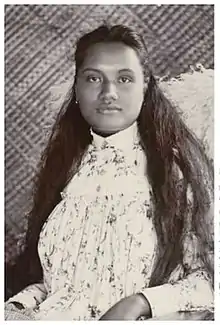
- Tuimanufili, (ruled as 20th Tui Manu'a)
- Siliave, (ruled as 23rd Tui Manu'a)
- Seuea, (ruled as 27th Tui Manu'a)
- Matelita, (ruled 1891–1895, as 39th Tui Manu'a)
Australia
- Victoria (ruled 1901)
- Elizabeth II (reigned 1952–2022)
Bora Bora
- Teriimaevarua II (ruled 1860–1873)
- Teriimaevarua III (ruled 1873–1895)
Huahine
- Teha'apapa I (ruled 1760–1790)
- Teri'itaria II (ruled 1815–1852)
- Teha'apapa II (ruled 1868–1893)
- Teuhe (ruled 1888–1890) – she reigned under a rebellion government against her mother Queen Tehaapapa II
- Teha'apapa III (ruled 1893–1895)
Raiatea
- Tehauroarii (ruled 1881–1884)
- Tuarii (ruled till 1897) – she reigned under a rebellion government against the French with the support of Teraupo'o after Tamatoa VI abdicated.
Rapa Iti
- Daughter of Parima (ruled 1886–1887).
Rimatara
- Tamaeva IV (ruled 1876–1892)
- Tamaeva V (ruled 1892–1901)
Tahiti
Fiji
- Elizabeth II (reigned 1970–1987)
Hawaii
- Ancient
- Kalanikauleleiaiwi, co-ruler of Hawaiʻi Island along with her brother Keaweʻīkekahialiʻiokamoku (ruled 1695–1725)
- Ululani, Chiefess of Hilo
- Kapau-a-Nuʻakea, 3rd Chiefess of Molokai
- Kamauliwahine, 4th Chiefess of Molokai
- Hualani, 5th Chiefess of Molokai
- Kanealai, Chiefess of Molokai
- Kūkaniloko, 11th Moʻi of Oʻahu
- Kalaimanuia, 12th Moʻi of Oʻahu (ruled 1600–1665)
- Kaikilani, 17th Moʻi of Hawaiʻi Island (ruled 1575–1605)
- Keakamahana, 19th Moʻi of Hawaiʻi Island (ruled 1635–1665)
- Keakealaniwahine, 20th Moʻi of Hawaiʻi Island (ruled 1665–1695)
- Kamakahelei, 22nd Moʻi of Kauaʻi (ruled 1770–1794)
- Kingdom
- Liliʻuokalani (ruled 1891–1893 and claimed status as queen until her death in 1917) – the only queen regnant of the Kingdom of Hawaii established by Kamehameha I
New Zealand
- Elizabeth II (reigned 1952–2022)
Rarotonga
- Makea Takau Ariki, Queen/Supreme High Chiefess of the Cook Islands (ruled 1871–1911) – was the last monarch and only queen regnant of the Kingdom of Rarotonga established in 1858, she ceased to be sovereign after 1888
Papua New Guinea
- Elizabeth II (reigned 1975–2022)
Solomon Islands
- Elizabeth II (reigned 1978–2022)
Tonga
- Tupoumahe'ofo (ruled 1777–1781, as Tu'i Kanokupolu)
- Salote Tupou III (ruled 1918–1965)
Tuvalu
- Elizabeth II (reigned 1978–2022)
Uvea (Wallis)
- Toifale (ruled 1825)
- Falakika Seilala (ruled 1858–1869)
- Amelia Tokagahahau Aliki (ruled 1869–1895)
- Aloisia Brial (ruled 1953–1958)
Legendary and mythological monarchs
Chile
- Gaboimilla
- Vakai, queen of Kingdom of Rapa Nui
China
- Nüwa, the only female among Three Sovereigns and Five Emperors
Kuba Kingdom
- Lobamba
- Go Kadi
- Gokare
Ecuador
- Paccha Duchicela, queen of the Kingdom of Quito
Egypt
- Nitocris of the Sixth Dynasty – Nitocris is mentioned within Herodotus' book Histories as being the last Pharaoh of the Sixth Dynasty of Egypt.
- Charoba – A queen mentioned in a history of Egypt written by 12th century Arab writer Murtada ibn al-'Afif.[29]
- Daluka of the Soleyman Dynasty – An Antediluvian monarch from medieval Coptic and Arabic texts who supposedly built a wall around Egypt to protect the country from invasion and also was said to have built a pyramid and a nilometer at Memphis. Sometimes claimed to be a cousin of Charoba and her immediate successor.[29]
- Borsa of the Soleyman Dynasty – Mentioned in medieval Coptic and Arabic texts as a ruler of Egypt in the Antediluvian era.[30] Sometimes described as a "priestess".[29]
Ethiopia
The following names all come from a regnal list written in 1922, which is partially based on native traditions and older regnal lists, but also contains additional names of Coptic and Nubian origin, the latter due to its association with the word "Aethiopia" in ancient and Biblical texts. Claimed dates follow the Ethiopian calendar.[31]
- Borsa (4321–4254 BC) – Originated from Coptic tradition.[30]
- Eylouka (3776–3731 BC) – Originated from Coptic tradition.[30]
- Nehasset Nais (2434–2404 BC)
- Kasiyope (1890–1871 BC) – Originated from Greek mythology.
- Mumazes (1675–1671 BC) – Daughter of king Bonu I.[32]
- Aruas (1671 BC) – Daughter of Mumazes.[31]
- Helena (1358–1347 BC)
- Makeda (1013–982 BC) – The Biblical queen of Sheba in Ethiopian tradition and mother of Menelik I. She succeeded to the throne after the death of her father king Kawnasya.[33]
- Nicauta Kandake I (740–730 BC)
- Hadina (372–362 BC) – Most regnal lists of Ethiopia claim this monarch reigned for 9 years.[34]
- Nikawla Kandake II (342–332 BC) – An alternate name for the Queen of Sheba[35]
- Akawsis Kandake III (325–315 BC)
- Nikosis Kandake IV (242–232 BC)
- Awsena (99–88 BC) – Most regnal lists of Ethiopia claim this monarch reigned for 1 year.[34]
- Nicotnis Kandake V (35–25 BC)
- Garsemot Kandake VI (40–50 AD) – Supposedly the Kandake from the Biblical story of the Ethiopian Eunuch.[31]
- Wakana (230 AD) – Reigned for 2 days.[31]
- Ahywa Sofya (299–332 AD) – Likely based on Sofya of Axum, mother of Ezana.
- Adhana I (369–374 AD) – Some regnal lists of Ethiopia claim this monarch reigned for 14 years.[36]
- Adhana II (412–418 AD) – Some regnal lists claim this monarch co-ruled with king Abreha III.[36]
Kingdom of Simien
- Gudit (ruled c. 960 – c. 1000)
Sidama people
Amazons
- Otrera, the daughter of Eurus (the east wind)
- Hippolyta, the Amazonian queen who possessed a magical girdle
- Penthesilea, the daughter of Ares and Otrera and the sister of Hippolyta, Antiope and Melanippe
- Antianara, the daughter of Ares and Otrera and the sister of Hippolyta, Antiope and Melanippe
- Eurypyle
- Lampedo
- Marpesia
India
- Yashovati, ruler of Kashmir – she was described in Rajatarangini
Indonesia
- Mahisa Suramardini Warmandewi, queen of Salakanagara (ruled 276–289 AD)[37]
- Sphatikarnawa Warmandewi, queen of Salakanagara (ruled 340–348 AD)[37]
Iran
Iraq
- Kubaba of Kish, the only queen on the Sumerian King List (ruled 25th century BC)
- Semiramis, the legendary queen of king Ninus, succeeding him to the throne of Assyria
- Nitocris of Babylon, the ruling queen of Babylon described by Herodotus in his Histories
Japan
- Empress Jingū (ruled 201–269)
- Iitoyo
Malaysia
Aztec Empire
- Atotoztli II (possibly ruled 1466–1472, disputed)
Myanmar
Norway
Pakistan
- Nur Bakht Khatun of Trakhan Dynasty
- the Dareli queen of Trakhan Dynasty
Poland
Russia
Somalia
- Amel Ali of Somali mythology
- Arawelo of Proto-Somali
South Africa
- Majaji (ruled c. 350 AD)
Sri Lanka
- Kuveni, queen of Yakkha people of Sri Lanka before the founding of Kingdom of Tambapanni
Sudan
- Pelekh Candace of Meroë (c. 345–332 BCE)
Tunisia
Turkmenistan
United Kingdom
- Queen Gwendolen (ruled 11th century BCE)
- Queen Cordelia (ruled 8th century BCE)
- Queen Marcia (ruled 4th century BCE)
Vietnam
- Lady Po Nagar of Champa, According to Cham legend, was the founder of the Cham nation
Yemen
- Bilkis in Yemen, claimed to be Queen of Sheba
Constituent queens
Botswana
- Mosadi Muriel Seboko (ruled 2002–present), the kgosikgolo of the Balete people
China
- Chen Shuozhen (ruled 653) – She led a peasant uprising in 653. During the rebellion, she declared herself huangdi. Jian Bozan recognized her as a female huangdi.[38]
Haiti
- Ti Memenne of La Gonâve (ruled c. 1920s) – she was the tribal ruler of La Gonâve
Jamaica
- Queen Nanny, leader of the Jamaican Maroons
New Zealand
- Te Atairangikaahu, queen of Māori (ruled 1966–2006)
Nigeria
Panama
- Rufina Santana, queen of Naso people (ruled 1982–1988)
United States Virgin Islands
- "Queen Mary" Thomas, "Queen Agnes" Salomon, and "Queen Mathilda" McBean – the leaders of the 1878 St. Croix labor riot
Chieftainess
Botswana
Burundi
Cameroon
Dominican Republic
- Higuanamá, also spelled Hiquanama, Cacica of Higüey, one of the Chiefdoms of Hispaniola – she was described by Las Casas in his A Short Account of the Destruction of the Indies[39]
Fiji
- Lala Mara, the Roko Tui Dreketi of Rewa (ruled 1957–2004)
- Teimumu Kepa, the Roko Tui Dreketi of Rewa (ruled 2004–present)
Ghana
Haiti
- Anacaona, Cacica of Jaragua, one of the Chiefdoms of Hispaniola
Ireland
- Grace O'Malley, also known as "The Pirate Queen", chieftainess of the Ó Máille clan in Umaill
Israel
- Deborah, the only female judge of Israelite tribes in Biblical judges
Kyrgyzstan
- Kurmanjan Datka, also known as "The Tsaritsa of Alai", tribal leader of Alay (ruled 1862–1876)
Malawi
Rarotonga
- Makea Te Vaerua Ariki, High Chiefess of Te Au O Tonga (ruled 1845–1857)
- Pa Upoko Takau Ariki, High Chiefess of Takitumu (ruled 1855–1890)
- Tinomana Mereana Ariki, High Chiefess of Puaikura (ruled 1881–1908)
Nigeria
Xhosa
- Nosizwe Tyali, Chief of Imingcangathelo
- Nosiseko Gaika, Chief of Amambombo (Ngqika)
- Nomasilakhe Komani, Chief of Imingqalasi
Crow tribe
- Pine Leaf (ruled 1830s)
Giluts'aaw
- Victoria Young
Pamunkey
- Cockacoeske (ruled 1656–1686)
- Queen Betty (ruled 1686–1708?)
- Queen Ann (ruled 1708?–1723?)
Pocasset Wampanoag
Sakonnet
Seneca tribe
- Queen Alliquippa (ruled 1754)
Yemen
Female rulers of semi-independent feudal states
Duchy of Durazzo
- Joanna (ruled 1348–1368)
Principality of Albania
- Helena Thopia (ruled 1402–1403)
Principality of Valona
- Komnina Balšić (ruled 1385–1396)
- Ruđina Balšić (ruled 1414–1417)
Bangladesh
- Rani Bhabani, zamindar of Rajshahi Raj family
- Saratsundari Devi, zamindar of Puthia Raj family
- Hemanta Kumari Devi (bn:হেমন্ত কুমারী দেবী), zamindar of Puthia Raj family
Romania
- Catherine of Brandenburg, ruler of the Principality of Transylvania (ruled 1629–1630)
Female Rulers of crown land and personal union
Estonia
Part of the Kingdom of Denmark
- Margaret Sambiria (ruled 1266–1282)
Part of the Swedish Empire
- Christina (ruled 6 November 1632 – 6 June 1654)
- Ulrika Eleonora (ruled 5 December 1718 – 29 February 1720)
Part of the Russian Empire
- Catherine I (ruled 8 February 1725 – 17 May 1727)
- Anna (ruled 13 February 1730 – 28 October 1740)
- Elizabeth (ruled 6 December 1741 – 5 January 1762)
- Catherine II (ruled 9 July 1762 – 6 November 1796)
Finland
Part of the Kingdom of Sweden
- Margaret I of Denmark (ruled 1389–1412)
- Christina (ruled 1632–1654)
- Ulrika Eleonora (ruled 1719–1720)
Notes
- Kuckertz, Josefine (2021). "Meroe and Egypt". UCLA Encyclopedia of Egyptology: 5.
- Adam Simmons, 'A Short Note on Queen Gaua: A New Last Known Ruler of Dotawo (r. around 1520-6)?', Dotawo: A Journal of Nubian Studies (2023), doi:10.5070/D60060625.
- "Guinea Bissau Substates". guide2womenleaders.com.
- Basil Davidson (2014). West Africa Before the Colonial Era: A History to 1850. Routledge. p. 229. ISBN 978-1-317-88265-7.
- Palmer, H. R (1908). Journal of the Royal Anthropological Institute of Great Britain and Ireland. Vol. 1908.
- Stewart, John (2006). African States and Rulers (3rd ed.). London: McFarland & Company, Inc. p. 71. ISBN 9780786425624.
- Amirell, Stefan (2015). "Female Rule in the Indian Ocean World (1300–1900)". Journal of World History. 26 (3): 443–489. doi:10.1353/jwh.2015.0023. JSTOR 43901772. S2CID 141655723.
- Ben, Cahoon (ed.). "Madagascar Traditional States". World Statesmen.
- Evans-Pritchard, E. E. (2011). "The divine kingship of the Shilluk of the Nilotic Sudan". HAU: Journal of Ethnographic Theory. 1: 407–422. doi:10.14318/hau1.1.016. S2CID 162247139.
- Mwakikagile, Godfrey (2020-03-20). Colonial Mentality and the Destiny of Africa. African Renaissance Press. p. 144.
- McIntyre, Chris; McIntyre, Susan (2009). Zanzibar. Bradt Travel Guides. p. 8. ISBN 978-1-84162-254-5.
- Ingrams, W. H. (2020-10-28). Zanzibar: The Island Metropolis of Eastern Africa. Routledge. p. 95. ISBN 978-1-000-14405-5.
- Book of Sui, vol. 83
- Fan, Wenlan (1994). Zhongguo tong shi. Vol. 4. ISBN 978-7-01-002029-7.
- Old Book of Tang, vol. 197
- Jyotsna Kamat (2010-05-07). "Queen of Gersoppa: Chennabhairadevi, Brave Ruler of Gersoppa (1552–1606 C.E)". Kamatpotporri. Retrieved 2010-05-25.
- Jha, Makhan (1997). Anthropology of Ancient Hindu Kingdoms: A Study in Civilizational Perspective. M.D. Publications Pvt. Ltd. p. 157. ISBN 978-81-7533-034-4.
- De, Sushil Chandra (1990). Story of Freedom Struggle in Orissa. Orissa Sahitya Akademi. p. 36.
- Dani, Ahmad Hasan; Masson, Vadim Mikhaĭlovich; Unesco (2003-01-01). History of Civilizations of Central Asia: Development in contrast : from the sixteenth to the mid-nineteenth century. UNESCO. p. 238. ISBN 978-92-3-103876-1.
- Khan, Shah Ra'is (1987). Shah Ra'is Khan ki Tarikh-i Gilgit (in Urdu).
- O'Connor, Sue; McWilliam, Andrew; Brockwell, Sally (2020-09-07). Forts and Fortification in Wallacea: Archaeological and Ethnohistoric Investigations. ANU Press. p. 191. ISBN 978-1-76046-389-2.
- Syarifuddin, Ferry; Sakti, Ali (2021-02-08). Praktik Ekonomi dan Keuangan Syariah oleh Kerajaan Islam di Indonesia – Rajawali Pers (in Indonesian). PT. RajaGrafindo Persada. p. 83.
- Minh Thảo Phạm (2003). Chuyện các bà hoàng trong lịch sử Việt Nam (in Vietnamese). Nhà xuất bản Văn hóa thông tin.
- "Sigismund (Holy Roman emperor)". Encyclopædia Britannica. Britannica.com Inc. Retrieved 2012-05-29.
- Claus Krag. "Åsa Haraldsdatter, Dronning". Norsk biografisk leksikon.
- Nicholson, Oliver (19 April 2018). The Oxford Dictionary of Late Antiquity. Oxford University Press. p. 1316. ISBN 978-0-19-256246-3.
- Yáñez Neira, 54.
- Salvador Martínez, 32–33.
- Colavito, Jason. "Murtada ibn al-'Afif". Jason Colavito.
- Morié, Louis J. (1904). Histoire de L'Éthiopie (Nubie et Abyssinie): Tome Ier – La Nubie (in French). Paris. pp. 155–161.
{{cite book}}: CS1 maint: location missing publisher (link) - Rey, C. F. (1927). In the Country of the Blue Nile. London: Camelot Press. pp. 263–270.
- Araia, Ghelawdewos (December 7, 2009). "Brief Chronology of Ethiopian History". Retrieved 4 September 2022.
- Budge, E. A. Wallis (1928). A History of Ethiopia: Nubia and Abyssinia (Volume I). London: Methuen & Co. p. 193.
- Budge, E. A. Wallis (1928). A History of Ethiopia: Nubia and Abyssinia (Volume I). London: Methuen & Co. pp. 205–207.
- "Nicaula". Brooklyn Museum. Retrieved 13 November 2022.
- Budge, E. A. Wallis (1928). A History of Ethiopia: Nubia and Abyssinia (Volume I). London: Methuen & Co. pp. 259–261.
- "Salakanagara, Kerajaan (Sunda) Tertua di Nusantara". Nusantara Institute (in Indonesian). 2019-03-28. Retrieved 2023-07-14.
- 馮敏飛 (2016-01-01). 危世圖存 : 中國歷史上的15次中興 (in Chinese). 新華出版社. p. 355. ISBN 978-7-5166-2761-7.
- A Short Account of the Destruction of the Indies, Chapter III: Of the Kingdoms contained in Hispaniola
Bibliography
- L. Pierotti Cei, Madonna Costanza, Regina di Sicilia e d'Aragona, Mondadori, Milan 1995.
- S. Runciman, I Vespri siciliani, Rizzoli, Milan 1975.
External links
- Contemporary reigning queens (Zárate's Political Collections)

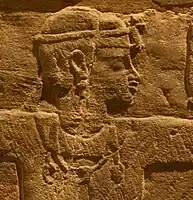

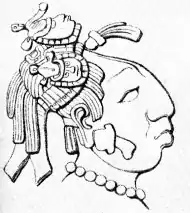




_effigy_2010_(2).jpg.webp)

